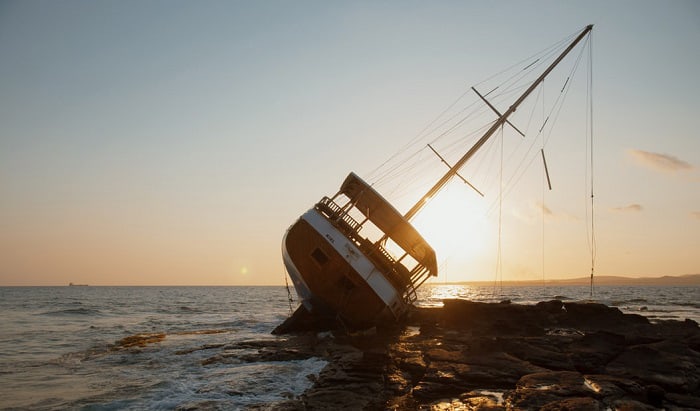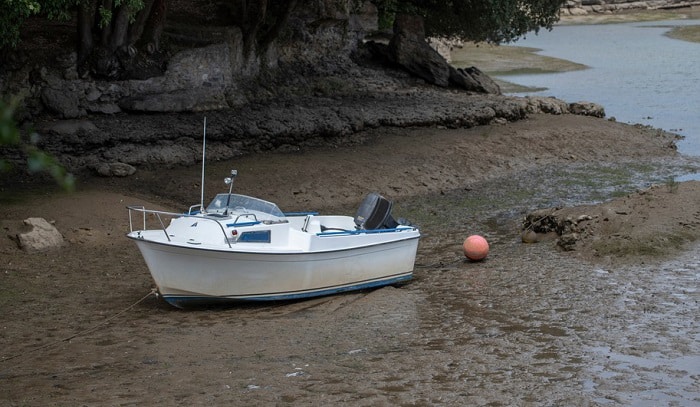Are you worried you might run aground when you go boating and damage your watercraft? You can avoid such anxieties and fears if you know what is the best way to avoid running aground.
Hitting the bottom is always possible, especially when you navigate unfamiliar waterways. However, there are several measures you can observe to avoid such a situation, which include understanding the rules of navigation, putting someone on the lookout, or making use of navigational charts and apps.
Let’s discuss these measures in more detail.
Table of Contents
Understand What Running Aground Means
Not everyone understands the run aground meaning. That is why it would be best to clarify any preconceived notions you may have about this phenomenon.
Running aground means hitting the boat’s hull against the bottom of a waterway. It happens if you pilot your vessel in shallow waters. The water is not deep enough to keep your watercraft afloat.
If you run your boat aground, it gets stuck in the sandy bottom or whatever geological feature is under the water. Depending on how fast you are going, you can damage your vessel’s hull, allowing water to leak and flood your boat. There is a detailed guide on things you should do first if your boat runs aground.
So, How Can You Avoid Running Aground
Situational awareness is essential when boating, especially in unfamiliar waters.
For starters, it would be best to check visibility levels. It may be effortless to spot a moving boat in the bay from the shore, but challenging when you are already in the water.
It will also help if you know the location of other watercraft in your immediate vicinity. If you notice many boaters avoiding a specific area, there must be a good reason for it.
Be vigilant about channel markers, especially non-lateral buoys. One buoy you should look out for is a hazard non-lateral marker.
This buoy is easy to spot because you can see an open-faced orange diamond on a white background. It also has two horizontal orange bands sandwiching the diamond.
A hazard buoy can indicate shallow waters, a shoal, rocks, or other threats under the water.
It is also essential to understand your boat’s maneuverability and stopping distance. You should be able to make a quick turn if you notice you are nearing shallow waters.
How Else Can You Avoid Running Aground
Even with a heightened sense of awareness cannot prevent running aground every time. When a boat runs aground, it could be due to other reasons. That is why it would be best to observe a few other things.
1. Assign Someone to be a Lookout
As a general rule, somebody in the boat must always stand watch for any objects on and in the water. For example, a sudden change in the water’s color from dark to light hue often indicates you are moving towards a shallower section.
In some instances, the lookout may even spot weed-beds under the water’s surface. These plants tell you that you are treading in depths not suitable for boating. You can have a boat stuck on sandbar if you proceed any further.
Unfortunately, spotting color changes can be difficult after heavy rain or in foggy weather. That is why the lookout must be able to identify wave pattern changes. Waves are more pronounced in shallow waters than in deep sections.
A good lookout must know how to interpret observations. For example, if you see a boat riding too high in the water – having a shallow draft – it could mean that the vessel is treading shallow depths. Or, it is also possible that the watercraft is too light that it does not displace that much water.
On the other hand, a cruise liner or a cargo ship with a deep draft can indicate the vessel is running in deeper waters. While you should steer clear of shipping lanes, this observation tells you that this particular area is safe enough for you to pilot your boat without running aground.
2. Go Easy on the Throttle
It is tempting to go full speed, especially if you do not see other vessels in the water. Unfortunately, over-speeding increases your risk of hitting the bottom.
When a boat runs aground at high speed, it can have disastrous consequences. Not only will you damage your watercraft beyond repair. There is also the risk of seriously hurting someone.
Maintaining a safe speed allows you to take evasive action once you spot the telltale signs of a shallow section. It also makes looking out for obstacles and hazards easier because you can focus more on the water.
It would be best to check navigational charts to determine the location of shallow waters, sandbars, shoals, and other potentially hazardous water areas.
However, you must realize that shoals and sandbars often shift like desert dunes. They may be on one spot of the sea today, another location the following day.
That is why it is crucial to stay updated with the location of these underwater geological formations and update your navigational chart, preferably before you go boating.
If you cannot update your navigational charts yourself, a marine navigation app can be an excellent option. You can download and install any of these programs on your smartphone and stay updated with the navigational charts in your location.
Some of the marine navigation apps worth checking out include C-Map Embark, iNavX, and KnowWake.
5. Consider Installing a Depth Finder
A depth finder works like a fish finder, except that it bounces sound signals off the sea bottom. If the sound reflection is too close, the device sends out an alarm and allows you to take the necessary action.
You can check the Sierra 260000P if you want. It is an in-dash digital depth finder you can mount in your boat’s transom or through the hull.
Conclusion
What is the best way to avoid running aground? It is to stay as vigilant as possible wherever you go boating. Knowing and understanding the rules of navigation, including how to read a navigational chart, can also help you shun running your vessel into a sandbar, shoal, or any other shallow-water section.
Using marine navigation apps and installing a depth finder in your boat can also improve your chances of not running aground. It will keep you safe, maintain your watercraft’s integrity, and make boating more fun and meaningful.

I am passionate about water sports and technical fields, so combining both makes me interested in making contents about boat accessories. With my partner, we went on many trips and sports games together, which led us to think about how we can spread our joys and passions to many people.



